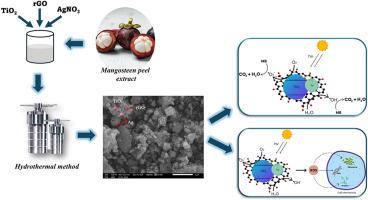Green biogenic synthesis of Ag-loaded TiO2/rGO nanocomposite and its prospective applications in antibacterial and self-cleaning surface coating
IF 4.7
3区 材料科学
Q2 MATERIALS SCIENCE, MULTIDISCIPLINARY
引用次数: 0
Abstract
Mangosteen peel (Garcinia mangostana L.) contains secondary metabolites such as α-mangostin, which can act as natural bioreductors. In this study, mangosteen peel extract was utilized in the green synthesis of reduced graphene oxide (rGO) and titanium dioxide (TiO2) nanoparticles. Subsequently, Ag-loaded TiO2/rGO (Ag@TiO2/rGO) nanocomposite was synthesized via the hydrothermal method. The nanocomposite was characterized using FTIR, XRD, GSA, DRS UV–Vis, SEM-EDX, and TEM analyses. FTIR spectra confirmed the formation of Ag–TiO2 bonds with an absorption shift from 631 to 602.81 cm−1, while XRD revealed TiO2 in the anatase phase with an average crystal size of 18.155 nm. GSA analysis indicated a mesoporous structure (type IV) with a surface area of 88.277 m2 g−1. SEM and TEM images showed Ag successfully coated the TiO2/rGO. The modification with rGO and Ag doping reduced the band gap of TiO2 from 3.12 eV to 3.03 eV, leading to improved light absorption in the visible region. The photocatalytic test demonstrated excellent self-cleaning properties, achieving 99.76 % methylene blue degradation under visible light within 20 min. Antibacterial activity tests revealed inhibition zones of 15.33 mm for Escherichia coli (6 h irradiation) and 8.33 mm for Staphylococcus aureus (4 h irradiation), indicating strong and moderate activity, respectively. These findings highlight the potential of Ag@TiO2/rGO nanocomposites as efficient self-cleaning and antibacterial agents.

负载ag的TiO2/rGO纳米复合材料的绿色生物合成及其在抗菌和自清洁表面涂层中的应用前景
山竹皮(Garcinia mangostana L.)含有次生代谢产物α-山竹苷等,具有天然的生物还原作用。在这项研究中,山竹皮提取物用于绿色合成还原氧化石墨烯(rGO)和二氧化钛(TiO2)纳米粒子。随后,通过水热法制备了负载ag的TiO2/rGO (Ag@TiO2/rGO)纳米复合材料。采用FTIR、XRD、GSA、DRS、UV-Vis、SEM-EDX和TEM等方法对复合材料进行了表征。FTIR光谱证实了Ag-TiO2键的形成,吸收位移从631到602.81 cm−1,而XRD显示TiO2处于锐钛矿相,平均晶粒尺寸为18.155 nm。GSA分析表明其为中孔结构(IV型),表面积为88.277 m2 g−1。SEM和TEM图像显示Ag成功包覆TiO2/rGO。通过还原氧化石墨烯和Ag的掺杂改性,TiO2的带隙从3.12 eV减小到3.03 eV,从而提高了可见光区的光吸收。光催化测试显示了优异的自清洁性能,在可见光下20分钟内亚甲基蓝的降解率达到99.76%。对大肠杆菌(辐照6 h)和金黄色葡萄球菌(辐照4 h)的抑菌范围分别为15.33 mm和8.33 mm,显示出较强和中等的抑菌活性。这些发现突出了Ag@TiO2/还原氧化石墨烯纳米复合材料作为高效自清洁和抗菌剂的潜力。
本文章由计算机程序翻译,如有差异,请以英文原文为准。
求助全文
约1分钟内获得全文
求助全文
来源期刊

Materials Chemistry and Physics
工程技术-材料科学:综合
CiteScore
8.70
自引率
4.30%
发文量
1515
审稿时长
69 days
期刊介绍:
Materials Chemistry and Physics is devoted to short communications, full-length research papers and feature articles on interrelationships among structure, properties, processing and performance of materials. The Editors welcome manuscripts on thin films, surface and interface science, materials degradation and reliability, metallurgy, semiconductors and optoelectronic materials, fine ceramics, magnetics, superconductors, specialty polymers, nano-materials and composite materials.
 求助内容:
求助内容: 应助结果提醒方式:
应助结果提醒方式:


